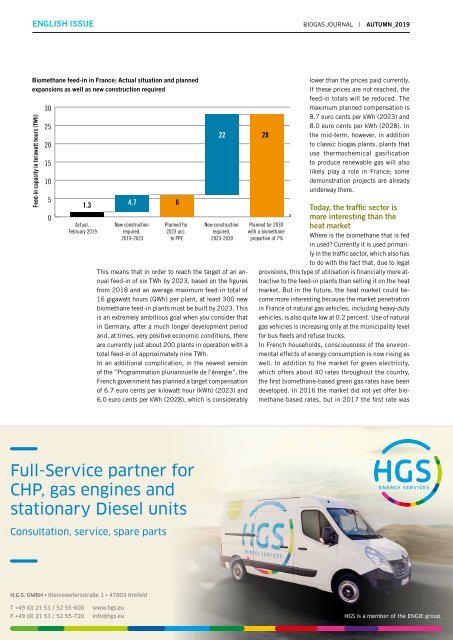Autumn 2019 EN
Create successful ePaper yourself
Turn your PDF publications into a flip-book with our unique Google optimized e-Paper software.
English Issue<br />
Biogas Journal<br />
| <strong>Autumn</strong>_<strong>2019</strong><br />
Biomethane feed-in in France: Actual situation and planned<br />
expansions as well as new construction required<br />
Feed-in capacity in terawatt hours (TWh)<br />
30<br />
25<br />
20<br />
15<br />
10<br />
5<br />
0<br />
Actual,<br />
February <strong>2019</strong><br />
1.3 4.7<br />
New construction<br />
required,<br />
<strong>2019</strong>-2023<br />
Planned for<br />
2023 acc.<br />
to PPE<br />
22 28<br />
New construction<br />
required,<br />
2023-2030<br />
This means that in order to reach the target of an annual<br />
feed-in of six TWh by 2023, based on the figures<br />
from 2018 and an average maximum feed-in total of<br />
16 gigawatt hours (GWh) per plant, at least 300 new<br />
biomethane feed-in plants must be built by 2023. This<br />
is an extremely ambitious goal when you consider that<br />
in Germany, after a much longer development period<br />
and, at times, very positive economic conditions, there<br />
are currently just about 200 plants in operation with a<br />
total feed-in of approximately nine TWh.<br />
In an additional complication, in the newest version<br />
of the “Programmation pluriannuelle de l’énergie”, the<br />
French government has planned a target compensation<br />
of 6.7 euro cents per kilowatt hour (kWh) (2023) and<br />
6.0 euro cents per kWh (2028), which is considerably<br />
6<br />
Planned for 2030<br />
with a biomethane<br />
proportion of 7%<br />
lower than the prices paid currently.<br />
If these prices are not reached, the<br />
feed-in totals will be reduced. The<br />
maximum planned compensation is<br />
8.7 euro cents per kWh (2023) and<br />
8.0 euro cents per kWh (2028). In<br />
the mid-term, however, in addition<br />
to classic biogas plants, plants that<br />
use thermochemical gasification<br />
to produce renewable gas will also<br />
likely play a role in France; some<br />
demonstration projects are already<br />
underway there.<br />
Today, the traffic sector is<br />
more interesting than the<br />
heat market<br />
Where is the biomethane that is fed<br />
in used? Currently it is used primarily<br />
in the traffic sector, which also has<br />
to do with the fact that, due to legal<br />
provisions, this type of utilisation is financially more attractive<br />
to the feed-in plants than selling it on the heat<br />
market. But in the future, the heat market could become<br />
more interesting because the market penetration<br />
in France of natural gas vehicles, including heavy-duty<br />
vehicles, is also quite low at 0.2 percent. Use of natural<br />
gas vehicles is increasing only at the municipality level<br />
for bus fleets and refuse trucks.<br />
In French households, consciousness of the environmental<br />
effects of energy consumption is now rising as<br />
well. In addition to the market for green electricity,<br />
which offers about 40 rates throughout the country,<br />
the first biomethane-based green gas rates have been<br />
developed. In 2016 the market did not yet offer biomethane-based<br />
rates, but in 2017 the first rate was<br />
Full-Service partner for<br />
CHP, gas engines and<br />
stationary Diesel units<br />
Consultation, service, spare parts<br />
H.G.S. GmbH • Kleinewefersstraße 1 • 47803 Krefeld<br />
T +49 (0) 21 51 / 52 55-600<br />
F +49 (0) 30 21 51 / 52 55-720<br />
www.hgs.eu<br />
info@hgs.eu<br />
HGS is a member of the <strong>EN</strong>GIE group.


















